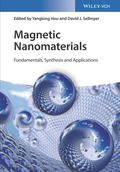Magnetic Nanomaterials
Fundamentals, Synthesis and Applications

1. Edition August 2017
600 Pages, Hardcover
209 Pictures (132 Colored Figures)
Monograph
Buy now
Price: 209,00 €
Price incl. VAT, excl. Shipping
Euro prices for Wiley-VCH and Ernst & Sohn titles are only valid for Germany. In EU countries, local VAT applies. Postage will be charged.
- Out of print -
Timely and comprehensive, this book presents recent advances in magnetic nanomaterials research, covering the latest developments, including the design and preparation of magnetic nanoparticles, their physical and chemical properties as well as their applications in different fields, including biomedicine, magnetic energy storage, wave-absorbing and water remediation.
By allowing researchers to get to the forefront developments related to magnetic nanomaterials in various disciplines, this is invaluable reading for the nano, magnetic, energy, medical, and environmental communities.
OVERVIEW OF MAGNETIC NANOMATERIALS
Introduction
Classification of Typical Magnetic Nanomaterials
Characterization of Magnetic Nanomaterials
MAGNETISM OF NANOMATERIALS
Introduction
Magnetism and Spintronics
Magnetic Properties of Magnetic Nanomaterials
Magnetization Process
Magnetic Anisotropy
PART II. Synthesis
OVERVIEW OF SYNTHESIS OF MAGNETIC NANOMATERIALS
Introduction
General Synthesis Mechanism of Magnetic Nanomaterials
SYNTHESIS OF SOFT MAGNETIC NANOMATERIALS AND ALLOYS
Introduction
Metal
Metals Oxides
Metal Carbides, Nitrides
Alloys and Beyond
Conclusions and Perspectives
SYNTHESIS OF RARE EARTH PERMANENT NANOCOMPOSITE MAGNETS
Introduction
SmCox-Based Magnets
NdFeB-Based Magnets
Conclusions and Perspectives
SYNTHESIS OF RARE EARTH FREE PERMANENT MAGNETS
Introduction
FeNx
MnB
Others
Conclusions and Perspectives
SYNTHESIS OF MAGNETIC CHALCOGENIDES
Introduction
Synthesis
Properties
Conclusions and Perspectives
SYNTHESIS OF TYPICAL MAGNETIC NANOSTRUCTURES
Introduction
Synthesis of Hollow/Porous Magnetic Nanoparticles
ORGANIZED ENSEMBLES OF MAGNETIC NANOMATERIALS
Introduction
Essential Conditions for Ordered Structures
Self-Assembly Method of Magnetic Nanomaterials
PART III. Applications
MAGNETIC NANOMATERIALS FOR BIOTECHNOLOGY
Introduction
Magnetic Nanomaterials for Biosensors
Magnetic Nanomaterials for Bioseparation
Conclusions and Perspectives
MAGNETIC NANOMATERIALS FOR DIAGNOSTICS
Introduction
Biocompatibility of Magnetic Nanoparticles
Surface Functionalization of Magnetic Nanomaterials
Magnetic Resonance Imaging (MRI)
Magneto-Acoustic Tomography (MAT)
Magnetic Particle Imaging (MPI)
Multi-Modality Imaging
Conclusions and Perspectives
MAGNETIC NANOMATERIALS FOR THERAPY
Introduction
Imaging-Guided Therapy
Magnetic Hyperthermia
Targeted Drug and Gene Delivery
Conclusions and Perspectives
MAGNETIC NANOMATERIALS FOR DATA STORAGE
Introduction
Monodisperse Magnetic Nanoparticles
Magnetic Nanoparticle Assembly
Conclusions and Perspectives
MAGNETIC NANOMATERRIALS FOR ELECTROMAGNETIC WAVE-ABSORBING
Introduction
Advantage of Magnetic Absorbing Nanomaterials
Theoretical Research
Magnetic Absorbing Nanomaterials
Conclusions and Perspectives
MAGNETIC NANOMATERIALS FOR WATER REMEDIATION
Introduction
Magnetic Adsorption Nanomaterials and Mechanism
Removal of Toxic Metal Ions and Dye
He has published over 110 papers in peer-reviewed scientific journals and has received numerous scientific awards, including the CCS-RSC Young Chemist and the JSPS Fellow award.
David J. Sellmyer received B.S. and Ph.D. degrees in Physics from the University of Illinois and Michigan State University, respectively. He was an Assistant and Associate Professor of Materials Science and Engineering at MIT before moving to the University of Nebraska where he became Chair of Physics, and presently George Holmes University Distinguished Professor. He is the founding Director of the Nebraska Center for Materials and Nano-science and the Nebraska Nanoscale Facility, a site of the NSF National Nanotechnology Coordinated Infrastructure.
He has authored or edited more than 650 publications, and is a Fellow of the American Physical Society and American Association for the Advancement of Science.


